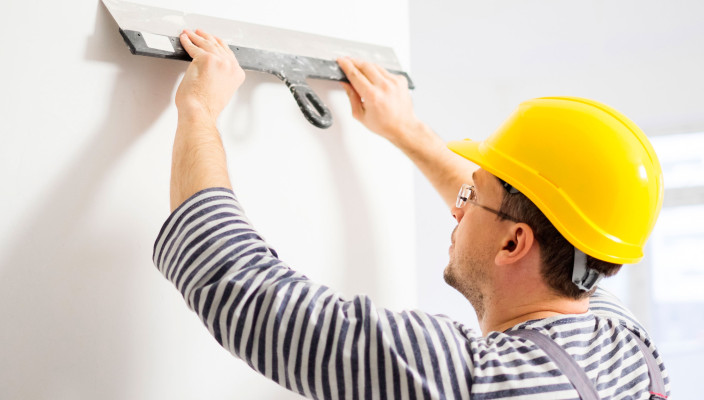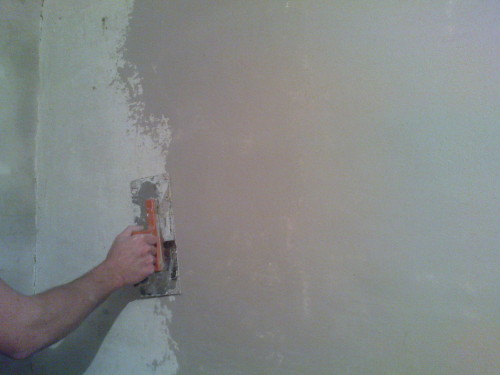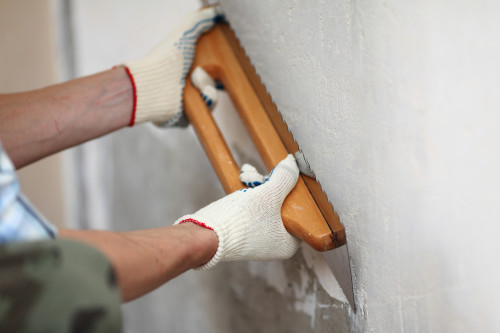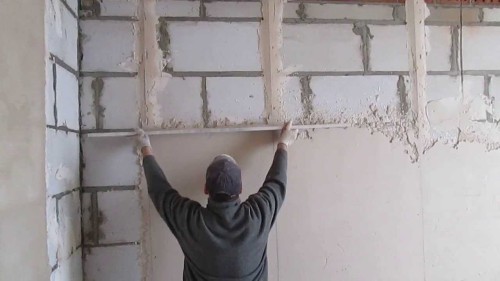Each owner should be able to hold plaster works. It must be said that they often are simple enough, so no special skill here is not needed. Despite this, directly preparatory work, the choice of the best materials, as well as some other moments, can take away a lot of time. Accordingly, it is for this that it should be paid first.
Content
Many specialists advise to involve plaster professionals. Of course, you should not forget that such services will cost Neszayevo, especially if we are talking about a large room or all the dwelling.
If you do not have extra money, you should pay attention to our advice and recommendations presented in this material. Practice shows that it is possible to carry out the entire volume of plastering work, and get an excellent result. Moreover, the plus of repair itself is self-confidence that everything is done on conscience. Unfortunately, third-party workers are often trying to make everything quickly, and sometimes misses important details of the process.
In this material, we will analyze all aspects of the process of plastering walls, as well as consider the most important elements of this event and difficulties that often arise.
Features of the process of plaster walls
It is worth noting that many people are afraid to carry out the plaster walls due to the expected result. Of course, a lot of errors can be allowed without studying detailed instructions, which will definitely rush in the future.
Unfortunately, the current economic situation does not allow to fully train their workshop of plaster. In any case, such an experience is desirable, since it is the practice that allows you to pay attention to the most important elements of the process.
Of course, if there are at least a bit of unnecessary plaster, you can practic a little, and it will definitely bring a lot of benefit.
If it is decided to use the services of third-party specialists, then, first of all, you need to be confident in their qualifications. You should explore the reviews, or, if possible, invite the guys who have been repaired from acquaintances or friends. In this case, we have an example of work, as well as we can be confident in good quality of the provision of services.
You can use any options for the repair process, but most importantly is a qualitative result. Do not be afraid to overpay a little.
Many experts recommend to participate in the ceiling plaster, as it is somewhat easier than plastering the walls.
Type of plaster
To begin with, it is worth knowing that 2 types of plaster are on sale:
- Dry. This type of plaster is often drywall and other shearing materials. Experts recommend using it in the event that there are no special requirements for the surface. The thing is that the dry plaster is much cheaper than wet, and the result is excellent. The most important thing is that at the end we get a perfectly smooth surface, as the sheaving plates are often large in size, and it creates certain convenience. It is bad that for the walls of the walls, it is often necessary to equip the metal frame, prepare the surface under the fastening of the trim. Despite all this, every year plasterboard is becoming more and more relevant material, as it is an inexpensive alternative to other finishing resources.
- Wet Obviously, this type of plaster is applied using a spatula, and its weight is much larger than that of the dry option. It must be said that the process of applying this plaster on the surface is not easy task, as it is very difficult to avoid irregularities, as well as many other flares, especially if the room is large, and the ceiling is high. Often, experts are joking that for such works, a person should have a steady psyche, as well as the lack of trembling in their hands, otherwise irregularities cannot be avoided. In fact, the skill comes only after practice. If you put the plaster with a very thin layer, then you can achieve some savings, but this is not always an appropriate option.
Cost of material
Of course, the price issue is always relevant, especially when it comes to large-scale repair work. If we plan to hold the entire room plaster, then the volume of materials will be considerable. In such conditions, it is quite possible to save on some resources.
Unfortunately, the cost of wet plaster is now very high, and with each month the price tag is growing rapidly. In such conditions, you need to choose the most acceptable option, but at the same time not to sacrifice the quality. Most often, experts are recommended to make a choice in favor of well-known manufacturers of building materials. Of course, in such conditions you can face large charges that are not all able to withstand. At the same time, you can pay attention to manufacturers who are just trying to enter large markets. Most often, products from such companies are not too high. But it is also necessary to analyze the quality of plaster, and for this you can explore the reviews, go to the manufacturer's website, or to carry out the experiment itself.
Considering that even costly specialist services can be added to the high cost of the material, repair activities may be very expensive. You need to know about it, especially if the financial budget is limited.
Again, you should always remember that almost any of the situation can be found out. For example, if the wet plaster is too ambiguous option, you can always take a look in the direction of plasterboard. Of course, it is only part of those materials that can be found in building stores. Consultants will always pick up the materials that will be cheaper, but according to the characteristics and basic properties will be not worse than the above resources. At the same time, it is necessary to navigate a little in this matter, so as not to become a victim of deception.
Selection of tools for repair work
Most construction and repair work begins with the choice of tools and devices. In this case, if we are talking about the plaster of the walls, we will need several tools at once, which will significantly simplify the entire process.
Among these tools:
- spatula wide;
- spatula flat;
- rule;
- trowel;
- falcon.
It should be noted that, for example, it is possible to do without a wide spatula, but then the process of plastering may not be easier, since the alignment of the mixture can be held on a wide variety of sections.
If we talk about the role of a falcon in this process, then often this tool is used to smoke already grabbed plaster. Experts who regularly conduct plaster walls often tighten the falcon felt, so that the surface becomes perfectly smooth.
With the help of the rule, it is advisable to check the basic surface of the surface after applying plaster. In addition, they can align the mixture that has not yet frozen.
Types of wet plaster
It should be borne in mind that if you need to stack the walls, then often we are talking about several separate layers of material that will allow achieving the optimal result as part of certain repair work.
- Primer. This layer is a relatively flat, but perhaps a rough surface, which is best suited for cladding or wall sheat. The main thing when creating this layer is the flatness of the surface, which is achieved even with high roughness of plaster. The latter allows for excellent grip with tiles (or other material).
- Finish. If we are talking about the finish plaster, it is often a full-fledged layer that can be an independent decorative component of the room. By the way, the finish plaster can be applied to the primer. The most important requirement that is often used by professionals is to ensure a single resistant material tone. If after applying plaster it is planned to cover with a mirror enamel, you need to provide a perfectly level surface.
- Protective. This type of wet plaster is used quite often. The most interesting thing is that you can find plaster, which can even reduce the radiation background. At home, protective plaster is often used to combat dampness. For example, the stucco can be separated the basement. Often, such material is characterized by high strength, as well as resistance to moisture.
- Outdoor. The main requirement for this plaster is resistance to external influences. This mixture is produced on the basis of cement, so the strength of the products is quite high.
Acquisition of the finished mixture
As we mentioned earlier, the plaster consists of several important components. Most often, experts personally create plaster necessary for certain needs, but this is a complex process that consists in choosing the most appropriate components, as well as their proportions.
Fine mixtures are enjoying great popularity, which in construction stores are sold in colossal volumes. And there you can find plaster with those or other properties, as well as other features. For beginners, it is advisable to pay attention to such products, since in such conditions there is no likelihood of error assumptions associated with components and proportions.
It is worth noting that there are many products from European construction brands on sale, but domestic materials are considerably popular. Of course, the second is somewhat cheaper, but you can get on poor-quality material, which in the future will make a lot of problems. Again, you should explore the reviews available on the Internet, as well as if necessary, consult with experts who will give their assessment of the existing situation.
The process of plastering walls
Preparation of the surface
Before applying the plaster on the wall, it is necessary to pay attention to the following steps of the repair process, without which it is unlikely to get a remnant result:
- complete surface cleaning;
- delete defects;
- processing surface under the plaster.
To begin with, we need to get rid of all that remains on the surface. Often these are old wallpapers that need to be removed from the wall by any ways. Often, washouts for wallpapers, which show themselves extremely effectively. This process will also need a spatula.
If you need to remove the old plaster, then in most cases the material is simply wetted with water temperature and is withstanding in a closed space. After that, the plaster is easily removed using a spatula.
As for the removal of defects, it is often referring to cracks or small recesses. On the wall of the wall such problem places can be a lot. Small defects are corrected using plastering primer. It is especially important to get rid of all the problems available at the plinth level. There is often a fungus that can adversely affect the entire surface that will succumb to the finish.
Spray wall
As for the walls of the walls, this is the process required to create a relic. The essence lies in the fact that we throw a little mixture on the wall, and only when the plaster will occur, the mixture will be in better way to surface.
For this case, we will need Kelma to which some plaster stacked. After that, with a strong zamach, pieces of material must stick to the wall. The height of each such lump should reach no more than 7 mm.
It is important to note the fact that the plaster should not be frozen. It is necessary to give her a little grab. In order not to miss the moment, you should check the condition of the material by pressing the finger on it.
Plaster without Mayakov
If it is decided to hold plaster walls without lighthouses (applying a thin layer of material), it is necessary to arm a falcon. Using the cells, a small amount of material is superimposed on it. The plaster is applied to the wall at a sharp angle and is evenly distributed over the surface.
It should be borne in mind that this process is quite complicated, since it is not always easy to provide a thin layer of material, especially if the wall has some irregularities. Accordingly, without experience here it is unlikely to succeed.
Plaster for beacons
Often, beacons are long metal elements for which the process of plastering will be carried out.
The installation of beacons occurs vertically using self-tapping screws or mounting glue. It is important to keep in mind that uneven walls complicate the fastening of lighthouses, and third-party help may need in such situations.
Most often it is necessary to install the first lighthouse, and the plumb is lowered on it. Obviously, it is necessary to ensure the same level of the location of the elements to make the plaster in the best way on the wall.
It should be noted that with the help of self-samples, you can provide the most appropriate level of beacons for holding plaster, since the fasteners can be adjusted enough flexibly, changing the position of the beacon.
Accordingly, after we have achieved the correctness of the location of the lighthouses, you can start plastering walls. To do this, again, all the above tools will be needed. It is most important to pay attention to the fact that the plasters for this process may need quite a lot, especially if the height of lighthouses is considerable. It is desirable to choose a spatula that corresponds to the distance between two lighthouses. So we get the opportunity to provide a perfectly smooth surface, especially not paying attention to the rest of the walls.
Most questions from newcomers occurs during the plaster of the corners and slopes. Specialists recommend using an angular spatula, which is the best suitable for such hard-to-reach places. Even despite the presence of a tool, a certain experience in this business will not hurt.
Separately, I would like to note that on sale you can find many varieties of lighthouses that will easily cope with the tasks set. This or that view of the lighthouse for finishing works can be suitable for one room and do not come for another. This information needs to be seriously studied.
























